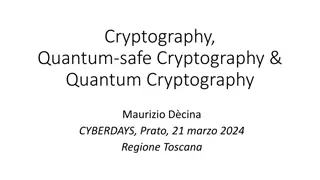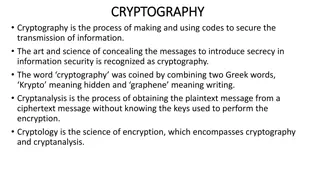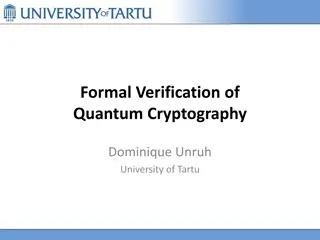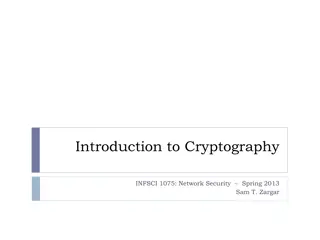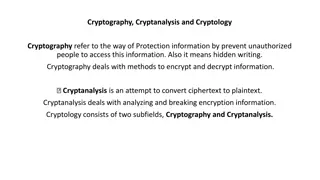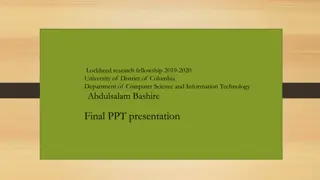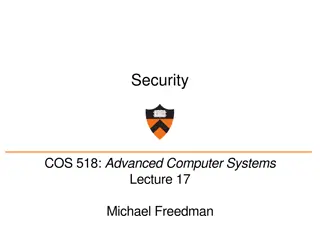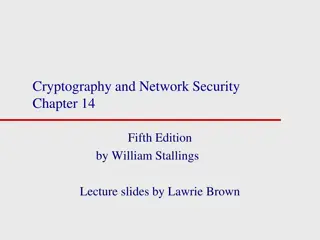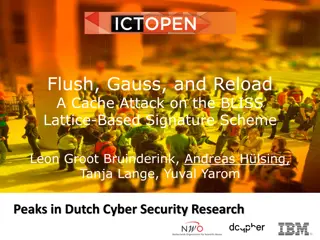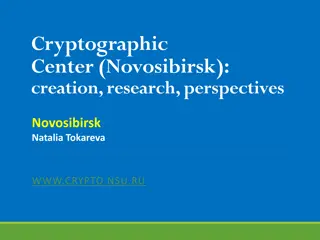
Exploring Cryptography: The Art of Securing Information
Delve into the world of cryptography with this comprehensive guide covering its definition, purpose, architecture, types, and more. Learn how cryptography safeguards data through encryption, authentication, confidentiality, integrity, and non-repudiation.
Download Presentation

Please find below an Image/Link to download the presentation.
The content on the website is provided AS IS for your information and personal use only. It may not be sold, licensed, or shared on other websites without obtaining consent from the author. If you encounter any issues during the download, it is possible that the publisher has removed the file from their server.
You are allowed to download the files provided on this website for personal or commercial use, subject to the condition that they are used lawfully. All files are the property of their respective owners.
The content on the website is provided AS IS for your information and personal use only. It may not be sold, licensed, or shared on other websites without obtaining consent from the author.
E N D
Presentation Transcript
www.studymafia.org Seminar On CRYPTOGRAPHY Submitted To: www.studymafia.org www.studymafia.org Submitted By:
Index Introduction What is Cryptography? Purpose Of cryptography Architecture of cryptography Types of Cryptography Process of cryptography Types Of cryptography Algorithms Attacks of cryptography Conclusion References
INTRODUCTION The Internet or the global Internet is the internationally connected network of computer networks with addresses that are administrated by IANA (Internet address and Naming Authority). There are many aspects to security and many applications, ranging from secure commerce and payments to private communications and protecting passwords. One essential aspect for secure communications is that of cryptography.
What is Cryptography? Cryptography derived its name from a Greek word called krypto s which means Hidden Secrets . Cryptography is the practice and study of hiding information. It is the Art or Science of converting a plain intelligible data into an unintelligible data and again retransforming that message into its original form. It provides Confidentiality, Integrity, and Accuracy.
PURPOSE OF CRYPTOGRAPHY Authentication: The process of proving one's identity. (The primary forms of host-to-host authentication on the Internet today are name-based or address-based, both of which are notoriously weak.) Privacy/confidentiality: Ensuring that no one can read the message except the intended receiver. Integrity: Assuring the receiver that the received message has not been altered in any way from the original. Non-repudiation: A mechanism to prove that the sender really sent this message.
Types of Cryptography Secret Key Cryptography Single key used to encrypt and decrypt. Key must be known by both parties. Assuming we live in a hostile environment (otherwise - why the need for cryptography?), it may be hard to share a secret key.
Public Key Cryptography One of the keys allocated to each person is called the "public key", and is published in an open directory somewhere where anyone can easily look it up, for example by email address. Each entity has 2 keys: Private Key (a secret) Public key (well known).
Using Keys Private keys are used for decrypting. Public keys are used for encrypting.
TYPES OF CRYPTOGRAPHIC ALGORITHMS
Public/Private Key Cryptography Asymmetric key cryptography overcomes the key management problem by using different encryption and decryption key pairs. Having knowledge of one key, say the encryption key, is not sufficient enough to determine the other key - the decryption key. The mathematical relationship between the public/private key pair permits a general rule: any message encrypted with one key of the pair can be successfully decrypted only with that key's counterpart.
Hash functions Is a type of one-way function this are fundamental for much of cryptography. A one way function - is a function that is easy to calculate but hard to invert. It is difficult to calculate the input to the function given its output. The precise meanings of "easy" and "hard" can be specified mathematically. With rare exceptions, almost the entire field of public key cryptography rests on the existence of one-way functions.
Attacks of cryptography Cipher text only attack The only data available is a target cipher text Known plaintext attack A target cipher text Pairs of other cipher text and plaintext (say, previously broken or guessing)
Attacks of cryptography Chosen plaintext attacks A target cipher text Can feed encryption algorithm with plaintexts and obtain the matching cipher texts Chosen cipher text attack A target cipher text Can feed decryption algorithm with cipher texts and obtain the matching plaintext matching cipher texts
CONCLUSION We use different types of algorithms to establish security services in different service mechanisms. We use either private key cryptography or public key cryptography according to requirement. If we want to send message quickly we use private key algorithm and if we want to send messages secretly we use public key algorithm.
References www.studymafia.org www.google.com www.wikipedia.com
Thanks!!! Any Query

